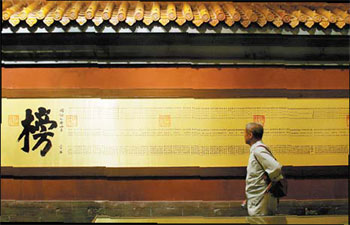Parents often bring their children to pay respects to Confucius and to visit the Imperial College, in hopes that they might become inspired to strive for academic excellence.
There have been renovations to both the interior and exterior of these venerable edifices.
Their historical layout and original state have been restored according to cultural relic protection guidelines. Replicated exhibits (of scholarly accoutrements) on display in Dacheng Hall of the Confucius Temple and Piyong Hall of the Imperial College explain their historical functions.

There is also a glazed pailou on the Jixian Gate entrance to the Imperial College. Built in 1783 during the reign of Qing Emperor Qianlong, it is the only pailou constructed specifically for an educational institution. It consists of three arches set in a red wall that supports the whole structure, topped with alternating green and yellow glazed tiles which represent solemn, imperial momentum. Stone relief carvings in the dragon, cloud and flower design adorn the wall. The personal inscription of Emperor Qianlong appears on both sides of the pailou.
Buildings on the east and west wings of the two complexes have been arranged into showrooms that house four exhibitions focusing on the museum's characteristics and cultural evolution.